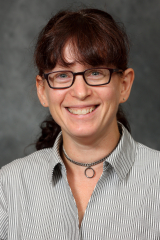
 Associate Professor
Associate Professor
BA (Princeton University, 1994)
PhD (University of Washington, 2000)
National Research Council Postdoctoral Fellow (Naval Research Laboratory, Washington DC, 2001-2003)
Research Chemist (Naval Research Laboratory, Washington DC, 2003-2008)
NRL Sigma Xi Young Investigator Award 2006
Contact Information
Office: Pulp & Paper 105
Phone: (514)398-6237
Email: Amy.Blum [at] mcgill.ca
Lab: Pulp & Paper 305/312A/314
Lab Phone: 514-398-6232
Web Page: Blum Group Website
Research Themes
- Chemical Physics
- Materials Chemistry
Research Description
Our group focuses on creating novel nanostructured devices and materials through self assembly. We take advantage of the unique properties of nanoscale and nanostructured materials by inventing new techniques for assembly and construction. Creating such materials will likely result in the emergence of previously unseen physical and chemical properties. Understanding and exploiting these properties will enable new and cheaper approaches to designed materials for many purposes such as photonics, electronics, and sensing applications.
We use biomolecules such as DNA, proteins, and intact virus particles as scaffolds to take advantage of the specificity and versatility they provide. These biotemplates give us access to a size scale that is difficult or impossible to reach using other techniques, particularly for assembly in three dimensions. Projects will use Tobacco Mosaic Virus and DNA as templates for organizing nanoparticles to generate hybrid materials with a negative index of refraction, molecular electronics-based nanosensors, magnetic nanoparticle-based data storage structures, and plasmonic structures that can act as waveguides or antennas.
Students joining the research effort can expect to gain experience in three core areas:
- Design of biotemplates and nanostructured materials using models, existing crystallographic data, and chemical intuition.
- Characterization of candidate molecular or nanoparticle components and of the assembled nanostructures using scanning probe and spectroscopic techniques.
- Self-assembly strategies on multiple size scales.
Currently Teaching